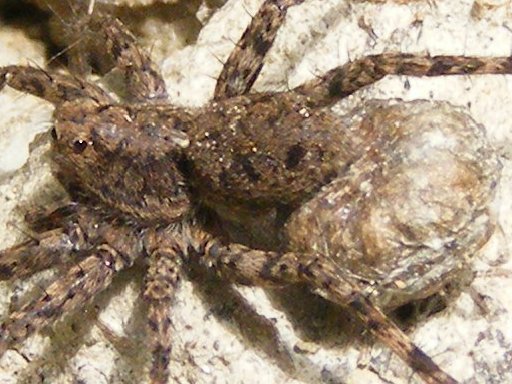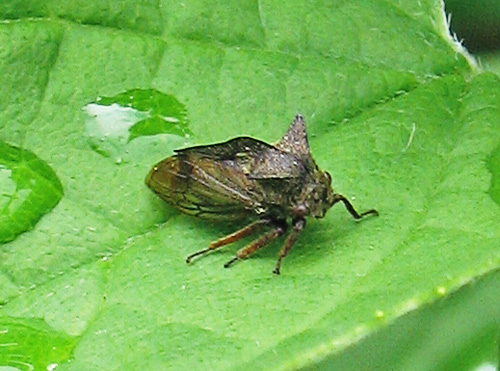|
Pardosa Milvina
''Pardosa milvina'', the shore spider, is a species in the wolf spider family. They are mainly found near rivers and in agricultural areas in eastern North America. ''P. milvina'' feed on a large variety of small insects and spiders. Ground beetles such as '' Scarites quadriceps'' and large wolf spiders such as ''Tigrosa helluo'' are predators of ''P. milvina''. ''P. milvina'' are smaller spiders with thin, long legs. This species captures prey such as arthropods with their legs and then kills them with their venom. Their predators are larger wolf spiders and beetles. ''P. milvina'' are able to detect these predators from chemotactile and vibratory cues. These spiders lose limbs when escaping from predators and they can change their preferred location in order to avoid predators. ''P. milvina'' also use chemical cues in order to mate. During their mating ritual, the male raises his legs and shakes his body. Both males and females can use silk, a chemotactile cue, for sexual commu ... [...More Info...] [...Related Items...] OR: [Wikipedia] [Google] [Baidu] |
Arthropod
Arthropods (, (gen. ποδός)) are invertebrate animals with an exoskeleton, a Segmentation (biology), segmented body, and paired jointed appendages. Arthropods form the phylum Arthropoda. They are distinguished by their jointed limbs and Arthropod cuticle, cuticle made of chitin, often Mineralization (biology), mineralised with calcium carbonate. The arthropod body plan consists of segments, each with a pair of appendages. Arthropods are bilaterally symmetrical and their body possesses an exoskeleton, external skeleton. In order to keep growing, they must go through stages of moulting, a process by which they shed their exoskeleton to reveal a new one. Some species have wings. They are an extremely diverse group, with up to 10 million species. The haemocoel, an arthropod's internal cavity, through which its haemolymph – analogue of blood – circulates, accommodates its interior Organ (anatomy), organs; it has an open circulatory system. Like their exteriors, the internal or ... [...More Info...] [...Related Items...] OR: [Wikipedia] [Google] [Baidu] |
Pardosa
''Pardosa'' is a large genus of wolf spiders, commonly known as the thin-legged wolf spiders. It was first described by C. L. Koch, in 1847, with more than 500 described species that are found in all regions of the world. Description THey are small to medium size wolf spiders, with clear and median and lateral bands on the carapace. They have relatively long legs with long spines on the foot. Which can be used to quickly identify some species. Species this genus contains 534 species: * '' Pardosa abagensis'' Ovtsharenko, 1979 – Russia, Abkhazia * ''Pardosa aciculifera'' Chen, Song & Li, 2001 – China * ''Pardosa acorensis'' Simon, 1883 – Azores * ''Pardosa adustella'' (Roewer, 1951) – Russia, Mongolia, China * '' Pardosa aenigmatica'' Tongiorgi, 1966 – Italy, Turkey, Azerbaijan * '' Pardosa afflicta'' (Holmberg, 1876) – Argentina * '' Pardosa agrestis'' ( Westring, 1861) – Palearctic * '' Pardosa agricola'' (Thorell, 1856) – Europe to Kazakhstan * ''Pardosa a ... [...More Info...] [...Related Items...] OR: [Wikipedia] [Google] [Baidu] |
Spinneret
A spinneret is a silk-spinning organ of a spider or the larva of an insect. Some adult insects also have spinnerets, such as those borne on the forelegs of Embioptera. Spinnerets are usually on the underside of a spider's opisthosoma, and are typically segmented. While most spiders have six spinnerets, some have two, four, or eight. They can move both independently and in concert. Most spinnerets are not simple structures with a single orifice producing a single thread, but complex structures of many microscopic spigots, each producing one filament. This produces the necessary orientation of the protein molecules, without which the silk would be weak and useless. Spigots can be singular or found in groups, which also permits spiders to combine multiple filaments in different ways to produce many kinds of silk for various purposes. Spinneret morphology can help arachnologists identify the taxon of a specimen and the specific morphology of a spigot can determine its use as well ... [...More Info...] [...Related Items...] OR: [Wikipedia] [Google] [Baidu] |
Pedipalp
Pedipalps (commonly shortened to palps or palpi) are the second pair of appendages of chelicerates – a group of arthropods including spiders, scorpions, horseshoe crabs, and sea spiders. The pedipalps are lateral to the chelicerae ("jaws") and anterior to the first pair of walking legs. Overview Pedipalps are composed of six segments or articles: the coxa, the trochanter, the femur, the short patella, the tibia, and the tarsus. In spiders, the coxae frequently have extensions called maxillae or gnathobases, which function as mouth parts with or without some contribution from the coxae of the anterior legs. The limbs themselves may be simple tactile organs outwardly resembling the legs, as in spiders, or chelate weapons ( pincers) of great size, as in scorpions. The pedipalps of Solifugae are covered in setae, but have not been studied in detail. Comparative studies of pedipalpal morphology may suggest that leg-like pedipalps are primitive in arachnids. At present, the only ... [...More Info...] [...Related Items...] OR: [Wikipedia] [Google] [Baidu] |
Mermithidae
Mermithidae is a family of nematode worms that are endoparasites in arthropods. As early as 1877, Mermithidae was listed as one of nine subdivisions of the Nematoidea. Mermithidae are confused with the horsehair worms of the phylum Nematomorpha that have a similar life history and appearance. Mermithids are parasites, mainly of arthropods. Most are known from insects, but some are recorded from spiders, scorpions and crustaceans. A few are known to parasitize earthworms, leeches and molluscs, and a specimen is known from a spider preserved in Baltic amber. At least 25 species are known to parasitize mosquito larvae, making them of considerable interest in biological control. A species, probably '' Pheromermis vesparum'', was recorded from the invasive Asian hornet (''Vespa velutina'') in France. The parasite was considered to be a member of the local fauna which had adapted to a new host. However, the authors concluded that the mermithid could not hamper the hornet invasion nor ... [...More Info...] [...Related Items...] OR: [Wikipedia] [Google] [Baidu] |
Ogcodes Eugonatus
''Ogcodes eugonatus'' is a species of small-headed flies (insects in the family Acroceridae). References Acroceridae Articles created by Qbugbot Insects described in 1872 Diptera of North America {{Nemestrinoidea-stub ... [...More Info...] [...Related Items...] OR: [Wikipedia] [Google] [Baidu] |
Acroceridae
The Acroceridae are a small family (biology), family of odd-looking flies. They have a hump-backed appearance with a strikingly small head, generally with a long proboscis for accessing nectar. They are rare and not widely known. The most frequently applied common names are small-headed flies or hunch-back flies. Many are bee or wasp mimicry, mimics. Because they are parasitoids of spiders, they also are sometimes known as spider flies. Description The Acroceridae vary in size from small to fairly large, about the size of large bees, with a wingspan over 25 mm in some species. As a rule, both sexes have tiny heads and a characteristic hump-backed appearance because of the large, rounded thorax. In appearance, they are compact flies without major bristles, but many species have a bee-like hairiness on their bodies, and some are bee or wasp mimicry, mimics. In most species, the eyes are holoptic in both sexes, the heads seemingly composed mainly of the large ommatidia, facete ... [...More Info...] [...Related Items...] OR: [Wikipedia] [Google] [Baidu] |
Spider
Spiders ( order Araneae) are air-breathing arthropods that have eight legs, chelicerae with fangs generally able to inject venom, and spinnerets that extrude silk. They are the largest order of arachnids and rank seventh in total species diversity among all orders of organisms. Spiders are found worldwide on every continent except for Antarctica, and have become established in nearly every land habitat. , 50,356 spider species in 132 families have been recorded by taxonomists. However, there has been debate among scientists about how families should be classified, with over 20 different classifications proposed since 1900. Anatomically, spiders (as with all arachnids) differ from other arthropods in that the usual body segments are fused into two tagmata, the cephalothorax or prosoma, and the opisthosoma, or abdomen, and joined by a small, cylindrical pedicel, however, as there is currently neither paleontological nor embryological evidence that spiders ever had ... [...More Info...] [...Related Items...] OR: [Wikipedia] [Google] [Baidu] |
Orthoptera
Orthoptera () is an order of insects that comprises the grasshoppers, locusts, and crickets, including closely related insects, such as the bush crickets or katydids and wētā. The order is subdivided into two suborders: Caelifera – grasshoppers, locusts, and close relatives; and Ensifera – crickets and close relatives. More than 20,000 species are distributed worldwide. The insects in the order have incomplete metamorphosis, and produce sound (known as a "stridulation") by rubbing their wings against each other or their legs, the wings or legs containing rows of corrugated bumps. The tympanum, or ear, is located in the front tibia in crickets, mole crickets, and bush crickets or katydids, and on the first abdominal segment in the grasshoppers and locusts. These organisms use vibrations to locate other individuals. Grasshoppers and other orthopterans are able to fold their wings (i.e. they are members of Neoptera). Etymology The name is derived from the Greek ὀρθό� ... [...More Info...] [...Related Items...] OR: [Wikipedia] [Google] [Baidu] |
Thysanoptera
Thrips ( order Thysanoptera) are minute (mostly long or less), slender insects with fringed wings and unique asymmetrical mouthparts. Different thrips species feed mostly on plants by puncturing and sucking up the contents, although a few are predators. Entomologists have described approximately 6,000 species. They fly only weakly and their feathery wings are unsuitable for conventional flight; instead, thrips exploit an unusual mechanism, clap and fling, to create lift using an unsteady circulation pattern with transient vortices near the wings. Many thrips species are pests of commercially important crops. A few species serve as vectors for over 20 viruses that cause plant disease, especially the Tospoviruses. Some species of thrips are beneficial as pollinators or as predators of other insects or mites. In the right conditions, such as in greenhouses, many species can exponentially increase in population size and form large swarms because of a lack of natural predators ... [...More Info...] [...Related Items...] OR: [Wikipedia] [Google] [Baidu] |
Homoptera
Homoptera is a suborder of order Hemiptera that is considered by some taxonomists to be paraphyly, paraphyletic, and therefore Deprecation, deprecated (obsolete). It was therefore split into the suborders Sternorrhyncha, Auchenorrhyncha, and Coleorrhyncha. The earlier work was based on nuclear DNA, but more recent phylogenetic analysis using mitochondrial DNA suggest that Homoptera may be a monophyletic group after all, a sister group of Heteroptera. The cause of the disparity in the analyses is suggested to be the long branch attraction effect in phylogenetic analysis, due to rapidly evolving DNA regions. The Homoptera include the aphids, scale insects, cicadas, and leafhoppers, which all have sucking mouthparts. References Insect suborders Hemiptera {{Hemiptera-stub ... [...More Info...] [...Related Items...] OR: [Wikipedia] [Google] [Baidu] |








